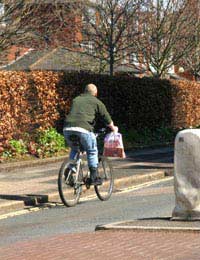Cycling and Walking for Sustainability

Cycling and walking are viable alternatives to the use of private cars or public transport, and are completely emission free forms of getting from 'A' to 'B'. They are, in fact, as yet the only readily available modes of transport that produce absolutely no emissions other than, arguably, biodiesel. When you consider, additionally, the very low cost of walking and cycling and the health benefits, there really is every incentive for the environmentally aware individual to maximise the use of both in their everyday routine.
With nearly half of all trips less than two miles, walking and cycling can easily account for 50% of all journeys made by reasonably healthy people. With 25% of all harmful fuel emissions being produced by road vehicles, the environmental impact in electing to walk or cycle rather than drive or take buses could be huge.
Walking
Walking has the obvious benefit of requiring no special equipment. It is safe, cost free and simple. It also adds to a sense of community, as individuals come into greater contact with each other when taking a stroll to the shops (for example) rather than a drive. For the environmentally aware, the simple pleasure of being able to look around, at parks, buildings rural and town centres is of obvious benefit, and can considerably contribute to personal well-being.Cycling
Cycling requires the use of a cycle as is relatively more dangerous than walking. However, with government initiatives to increase cycle lanes in full sway, and providing you are sensible and aware, cycling can be a viable transport option. Cycling can be used for journeys of up t several miles or more and where you do not have heavy goods to transport, it is, environmentally, the best option after car travel for journeys over 2-3 miles.Here are several easy ways to increase the amount you walk and cycle, whilst helping to reduce carbon emissions:
- Walk to the shops: Where possible try to shop locally, and buy locally produced food on foot, or by cycle. Shopping for local produce has benefits in itself, because it discourages the mass transport of goods by carbon-emitting vehicles.
- Walk or cycle for leisure: Take long walks or bike rides as an activity in themselves. This is an inexpensive way of sightseeing.
- Walk to work: Where possible, walk or cycle to work. Some councils run grant schemes to encourage people to purchase bikes for work purposes. Commuting takes a huge toll on the environment. Walking to work is a good way to collect your thoughts and get your mind and body 'kicking started' before facing the day ahead. If you live too far away to cycle or walk to work, it worth considering moving, or finally, taking public transport.
- Take walking and cycling holidays in the U.K: Rather than flying abroad (which consumes huge amounts of carbon), consider taking a hiking or cycling holiday in the U.K.


Re: Quiz: How Green is Your Life?
I appreciated this quiz because I discovered that with myself I can change something
Re: Quiz: How Green is Your Life?
Between 20-34 points You demonstrate a good environmental conscience – but there’s still room for improvement, so look at the…
Re: Quiz: How Green is Your Life?
I have got 25 points and I think it is okay, I feel good about it
Re: Quiz: How Green is Your Life?
I have 27 points and I think it's not bad but it could have been better.
Re: Quiz: How Green is Your Life?
I have 29 points, in my opinion it is quite a lot but on the other hand it could be better
Re: Quiz: How Green is Your Life?
I got 26 points so I think it's not bad but it could have been better. I will try to improve and live differently and better
Re: Quiz: How Green is Your Life?
Good check list and was happy to score high on most points. But I guess that is the case for most environmentally conscious folks…
Re: Fossil Fuel Debate
i have debate on consumption of fossil fuels. can you help me.
Re: Quiz: How Green is Your Life?
I am just wondering why tourism was left off your list? Surely unnecessary travel, needless environmental degradation, unabated…
Re: Fossil Fuel Debate
I am doing a debate about why fuel is good and this doesn't really help me.